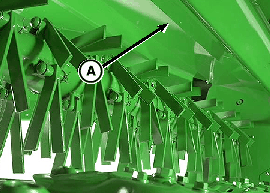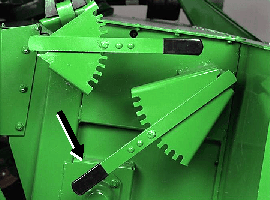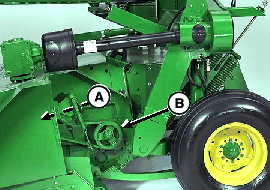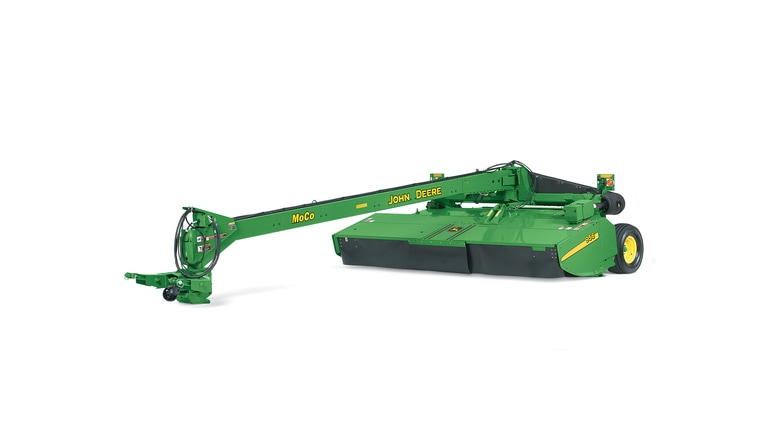-
+
Steel roll conditioners
 Impeller
Impeller
An impeller conditioner is available for the 946 and 956 Mower-Conditioners. Proper conditioning in a wide range of crops can be achieved when the conditioner is properly adjusted.
The impeller conditioner works well in legumes, especially alfalfa and most all-grass crops. Impeller conditioners are not recommended for thick-stemmed or cane-type crops over 5-ft tall.
How an impeller conditioner works:
-
1. As hay is cut by rotating knives, tines pick up the plants and carry them through the machine:
- 72 V-shaped tines
- Free-swinging tines are used to reduce damage if rocks or other solid objects are struck
-
2. As plant passes through, it rubs against the conditioning hood (A) and other plants.
 Impeller hood adjustment
Impeller hood adjustment
-
A simple lever adjustment (arrow) controls the spacing between the tines and the conditioning hood.
-
The closer the hood is to the tines, the more aggressive the conditioning is.
-
Adjustment slots give an easy reference point to control the degree of conditioning.
 Drive and driven sheaves
Drive and driven sheaves
3. The speed at which the tines rotate will also affect the degree of conditioning. Two impeller speeds can be achieved by interchanging the drive sheave (A) and the driven sheave (B).
- With sheaves in the position shown, the impeller turns at 871 rpm, which is ideal for most crop conditions
- Interchanging the sheaves will slow the impeller speed to 620 rpm
-
+
Modular-design cutterbar
 Impeller
Impeller
An impeller conditioner is available for the 946 and 956 Mower-Conditioners. Proper conditioning in a wide range of crops can be achieved when the conditioner is properly adjusted.
The impeller conditioner works well in legumes, especially alfalfa and most all-grass crops. Impeller conditioners are not recommended for thick-stemmed or cane-type crops over 5-ft tall.
How an impeller conditioner works:
-
1. As hay is cut by rotating knives, tines pick up the plants and carry them through the machine:
- 72 V-shaped tines
- Free-swinging tines are used to reduce damage if rocks or other solid objects are struck
-
2. As plant passes through, it rubs against the conditioning hood (A) and other plants.
 Impeller hood adjustment
Impeller hood adjustment
-
A simple lever adjustment (arrow) controls the spacing between the tines and the conditioning hood.
-
The closer the hood is to the tines, the more aggressive the conditioning is.
-
Adjustment slots give an easy reference point to control the degree of conditioning.
 Drive and driven sheaves
Drive and driven sheaves
3. The speed at which the tines rotate will also affect the degree of conditioning. Two impeller speeds can be achieved by interchanging the drive sheave (A) and the driven sheave (B).
- With sheaves in the position shown, the impeller turns at 871 rpm, which is ideal for most crop conditions
- Interchanging the sheaves will slow the impeller speed to 620 rpm
-
+
Windrow formation
 Impeller
Impeller
An impeller conditioner is available for the 946 and 956 Mower-Conditioners. Proper conditioning in a wide range of crops can be achieved when the conditioner is properly adjusted.
The impeller conditioner works well in legumes, especially alfalfa and most all-grass crops. Impeller conditioners are not recommended for thick-stemmed or cane-type crops over 5-ft tall.
How an impeller conditioner works:
-
1. As hay is cut by rotating knives, tines pick up the plants and carry them through the machine:
- 72 V-shaped tines
- Free-swinging tines are used to reduce damage if rocks or other solid objects are struck
-
2. As plant passes through, it rubs against the conditioning hood (A) and other plants.
 Impeller hood adjustment
Impeller hood adjustment
-
A simple lever adjustment (arrow) controls the spacing between the tines and the conditioning hood.
-
The closer the hood is to the tines, the more aggressive the conditioning is.
-
Adjustment slots give an easy reference point to control the degree of conditioning.
 Drive and driven sheaves
Drive and driven sheaves
3. The speed at which the tines rotate will also affect the degree of conditioning. Two impeller speeds can be achieved by interchanging the drive sheave (A) and the driven sheave (B).
- With sheaves in the position shown, the impeller turns at 871 rpm, which is ideal for most crop conditions
- Interchanging the sheaves will slow the impeller speed to 620 rpm
-
+
Excellent maneuverability
 Impeller
Impeller
An impeller conditioner is available for the 946 and 956 Mower-Conditioners. Proper conditioning in a wide range of crops can be achieved when the conditioner is properly adjusted.
The impeller conditioner works well in legumes, especially alfalfa and most all-grass crops. Impeller conditioners are not recommended for thick-stemmed or cane-type crops over 5-ft tall.
How an impeller conditioner works:
-
1. As hay is cut by rotating knives, tines pick up the plants and carry them through the machine:
- 72 V-shaped tines
- Free-swinging tines are used to reduce damage if rocks or other solid objects are struck
-
2. As plant passes through, it rubs against the conditioning hood (A) and other plants.
 Impeller hood adjustment
Impeller hood adjustment
-
A simple lever adjustment (arrow) controls the spacing between the tines and the conditioning hood.
-
The closer the hood is to the tines, the more aggressive the conditioning is.
-
Adjustment slots give an easy reference point to control the degree of conditioning.
 Drive and driven sheaves
Drive and driven sheaves
3. The speed at which the tines rotate will also affect the degree of conditioning. Two impeller speeds can be achieved by interchanging the drive sheave (A) and the driven sheave (B).
- With sheaves in the position shown, the impeller turns at 871 rpm, which is ideal for most crop conditions
- Interchanging the sheaves will slow the impeller speed to 620 rpm
-
+
Urethane roll conditioner
 Impeller
Impeller
An impeller conditioner is available for the 946 and 956 Mower-Conditioners. Proper conditioning in a wide range of crops can be achieved when the conditioner is properly adjusted.
The impeller conditioner works well in legumes, especially alfalfa and most all-grass crops. Impeller conditioners are not recommended for thick-stemmed or cane-type crops over 5-ft tall.
How an impeller conditioner works:
-
1. As hay is cut by rotating knives, tines pick up the plants and carry them through the machine:
- 72 V-shaped tines
- Free-swinging tines are used to reduce damage if rocks or other solid objects are struck
-
2. As plant passes through, it rubs against the conditioning hood (A) and other plants.
 Impeller hood adjustment
Impeller hood adjustment
-
A simple lever adjustment (arrow) controls the spacing between the tines and the conditioning hood.
-
The closer the hood is to the tines, the more aggressive the conditioning is.
-
Adjustment slots give an easy reference point to control the degree of conditioning.
 Drive and driven sheaves
Drive and driven sheaves
3. The speed at which the tines rotate will also affect the degree of conditioning. Two impeller speeds can be achieved by interchanging the drive sheave (A) and the driven sheave (B).
- With sheaves in the position shown, the impeller turns at 871 rpm, which is ideal for most crop conditions
- Interchanging the sheaves will slow the impeller speed to 620 rpm
-
+
Rotary disk cutterbar
 Impeller
Impeller
An impeller conditioner is available for the 946 and 956 Mower-Conditioners. Proper conditioning in a wide range of crops can be achieved when the conditioner is properly adjusted.
The impeller conditioner works well in legumes, especially alfalfa and most all-grass crops. Impeller conditioners are not recommended for thick-stemmed or cane-type crops over 5-ft tall.
How an impeller conditioner works:
-
1. As hay is cut by rotating knives, tines pick up the plants and carry them through the machine:
- 72 V-shaped tines
- Free-swinging tines are used to reduce damage if rocks or other solid objects are struck
-
2. As plant passes through, it rubs against the conditioning hood (A) and other plants.
 Impeller hood adjustment
Impeller hood adjustment
-
A simple lever adjustment (arrow) controls the spacing between the tines and the conditioning hood.
-
The closer the hood is to the tines, the more aggressive the conditioning is.
-
Adjustment slots give an easy reference point to control the degree of conditioning.
 Drive and driven sheaves
Drive and driven sheaves
3. The speed at which the tines rotate will also affect the degree of conditioning. Two impeller speeds can be achieved by interchanging the drive sheave (A) and the driven sheave (B).
- With sheaves in the position shown, the impeller turns at 871 rpm, which is ideal for most crop conditions
- Interchanging the sheaves will slow the impeller speed to 620 rpm
-
+
Impeller conditioner
 Impeller
Impeller
An impeller conditioner is available for the 946 and 956 Mower-Conditioners. Proper conditioning in a wide range of crops can be achieved when the conditioner is properly adjusted.
The impeller conditioner works well in legumes, especially alfalfa and most all-grass crops. Impeller conditioners are not recommended for thick-stemmed or cane-type crops over 5-ft tall.
How an impeller conditioner works:
-
1. As hay is cut by rotating knives, tines pick up the plants and carry them through the machine:
- 72 V-shaped tines
- Free-swinging tines are used to reduce damage if rocks or other solid objects are struck
-
2. As plant passes through, it rubs against the conditioning hood (A) and other plants.
 Impeller hood adjustment
Impeller hood adjustment
-
A simple lever adjustment (arrow) controls the spacing between the tines and the conditioning hood.
-
The closer the hood is to the tines, the more aggressive the conditioning is.
-
Adjustment slots give an easy reference point to control the degree of conditioning.
 Drive and driven sheaves
Drive and driven sheaves
3. The speed at which the tines rotate will also affect the degree of conditioning. Two impeller speeds can be achieved by interchanging the drive sheave (A) and the driven sheave (B).
- With sheaves in the position shown, the impeller turns at 871 rpm, which is ideal for most crop conditions
- Interchanging the sheaves will slow the impeller speed to 620 rpm


 Compare {{items.length}}/4
Compare {{items.length}}/4